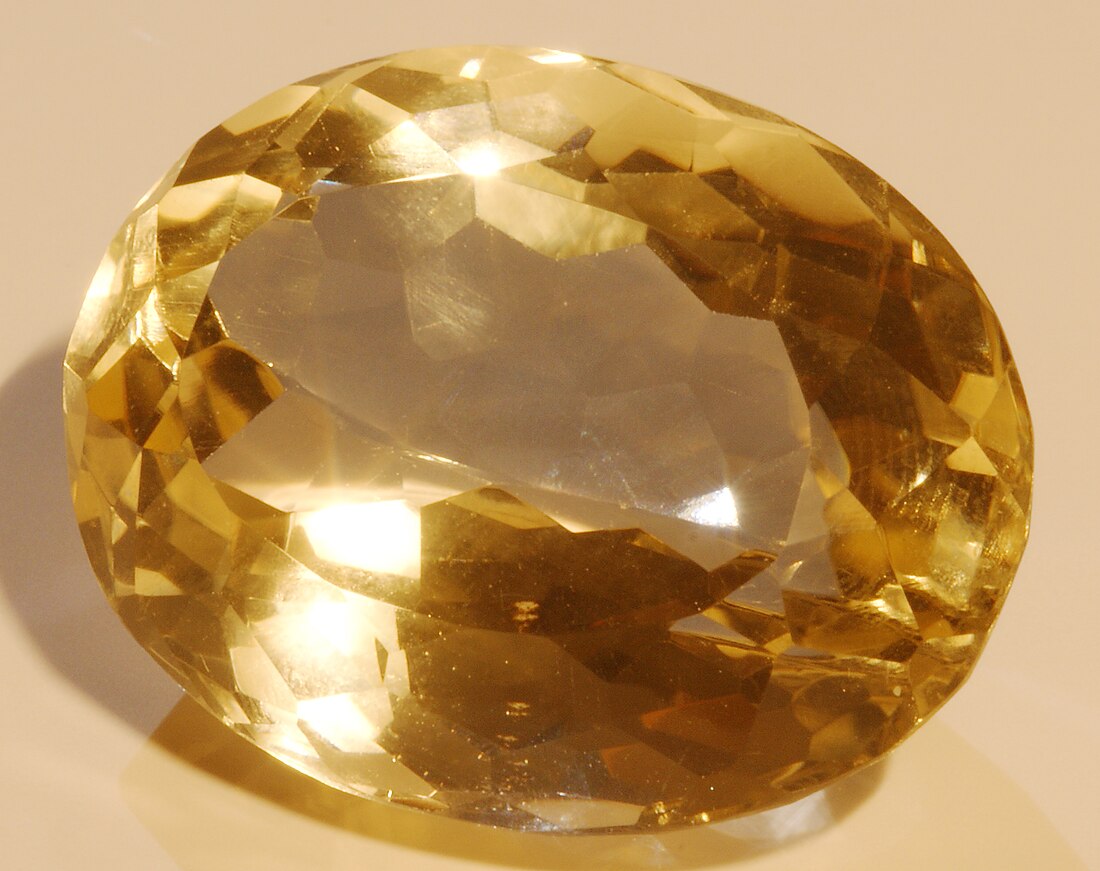Citrine (quartz)
Mineral, quartz variety From Wikipedia, the free encyclopedia
Citrine is a transparent, yellow variety of quartz. Its name is derived from the Latin word citrus (citron tree), by way of the French citrin or citron (lemon).[3] Citrine is one of the most popular yellow gemstones. It is sometimes used as a modern, more affordable alternative to the traditional November birthstone, topaz. Not every yellow quartz is considered citrine, and there is disagreement as to when the name "citrine" is appropriately used. However, quartz stained by iron inclusions or coatings is generally not considered citrine.
| Citrine | |
|---|---|
 Cut citrine from Brazil | |
| General | |
| Category | Tectosilicates, quartz variety |
| Formula | Silica (silicon dioxide, SiO2) |
| IMA symbol | Qz |
| Strunz classification | 4.DA.05 (Oxides) |
| Dana classification | 75.1.3.1 (Tectosilicates) |
| Crystal system | Trigonal |
| Crystal class | Trapezohedral (class 3 2) |
| Identification | |
| Color | Natural: pale yellow, with orange, green, or smoky hues Heat-treated amethyst: yellow-orange, orange-red, orange-brown |
| Crystal habit | Hexagonal, massive Heat-treated amethyst only: druzy, geodes |
| Twinning | Common: Dauphiné Law, Brazil Law, Japan Law |
| Cleavage | None |
| Fracture | Conchoidal |
| Mohs scale hardness | 7 |
| Luster | Vitreous |
| Streak | White |
| Diaphaneity | Transparent to translucent |
| Specific gravity | 2.65 |
| Optical properties | Uniaxial (+) |
| Refractive index | 1.544-1.553 |
| Birefringence | 0.009 |
| Pleochroism | Natural: weak dichroism (different shades of yellow or orange) Heat-treated amethyst: none |
| Dispersion | 0.013 |
| Common impurities | aluminum, iron |
| References | [1][2] |
Natural citrine is rare; most commercially available citrine is produced by heating amethyst or smoky quartz. Natural citrine tends to have a pale yellow, often smoky color, while heat-treated amethyst is typically a deeper yellow, orange, red, or even brown ("burnt amethyst").[1][4]
Color
Summarize
Perspective
- Twinned natural citrine crystals from Russia
- Natural citrine crystal from Brazil
- Cut natural citrine
- Tumbled "citrine" (heat-treated amethyst)
- "Citrine" crystal (heat-treated amethyst)
- "Citrine" geode (heat-treated amethyst)
Natural citrine ranges in color from yellow to yellow-orange or yellow-green. The causes of its color are not well agreed upon. Evidence suggests the color of citrine is linked to the presence of aluminum-based color centers in its crystal structure, similar to those of smoky quartz.[5][6] Both smoky quartz and citrine are dichroic in polarized light and will fade when heated sufficiently or exposed to UV light. They occur in the same geological environments and can frequently be found together in the same crystal as “smoky citrine.” Smoky quartz can also be converted to citrine by careful heat treatment. Alternatively, it has been suggested that the color of citrine may be due to trace amounts of iron; many sources claim iron oxides as the source of citrine's color.[1][7][8] However, synthetic crystals grown in iron-rich solutions have failed to replicate the color or dichroism of natural citrine. The UV-sensitivity of natural citrine further indicates that its color is not caused solely by trace elements.[2]
Most citrine on the market is heat-treated amethyst or smoky quartz. Amethyst loses its natural violet color when heated to above 200-300 °C and turns a color that resembles natural citrine, but is often more reddish or brownish.[9] Unlike natural citrine, the color of heat-treated amethyst is known to come exclusively from trace amounts of iron oxides, specifically hematite and goethite. This iron was present in the original amethyst and oxidized by the heating process. Heat-treated amethyst does not exhibit the dichroism of natural citrine.
Amethyst with a certain iron content can be heated to produce "madeira citrine," which has a deep orange color and exhibits red flashes. Its name comes from madeira, the Brazilian word for wood.[8] Clear quartz can also be irradiated to produce "lemon quartz," which has a neon yellow to yellow-green color.[1]
Differentiation

Clear quartz with natural iron inclusions or limonite staining may resemble citrine.[2] However, these crystals will either have coloration only on the surface or in certain spots (inclusions) within the crystal. Quartz that derives its color from coatings or inclusions is not citrine.

Like amethyst, heat-treated amethyst often exhibits color zoning, or uneven color distribution throughout the crystal. In geodes and clusters, the color is usually deepest near the tips.[9] Unlike heat-treated amethyst, natural citrine typically exhibits even coloration throughout the crystal and never occurs in geodes or clusters.

It is nearly impossible to differentiate between cut citrine and yellow topaz visually, but they differ in hardness. All quartz varieties have a hardness of 7 on the Mohs scale, while topaz has a hardness of 8.
Origin
Brazil is the leading producer of citrine, with much of its production coming from the state of Rio Grande do Sul. Other notable sources include Bolivia, the Democratic Republic of the Congo, Madagascar, Mexico, Myanmar, Namibia, Peru, Russia, South Africa, the United States, and Zambia.[1] Citrine has been referred to as the "merchant's stone" or "money stone", due to a superstition that it would bring prosperity.[10]
History
Quartz and its varieties have been used as gemstones for thousands of years. Citrine and other quartzes are believed to have been used by the ancient Egyptians to make talismans, by the ancient Greeks for carving symbols, and by Roman priests as rings. Queen Victoria was reportedly fond of the gemstone; many brooches and pendants featuring citrine survive from this era.[11] In the centuries before modern minerology, citrine was frequently confused with topaz. It was common in many cultures to use the name "topaz" for any golden yellow stone. The name "citrine" was first used in English in the 14th century.[12] Its popularity greatly increased once it was discovered citrine could be produced artificially by heating amethyst or smoky quartz.
See also
References
Wikiwand - on
Seamless Wikipedia browsing. On steroids.






